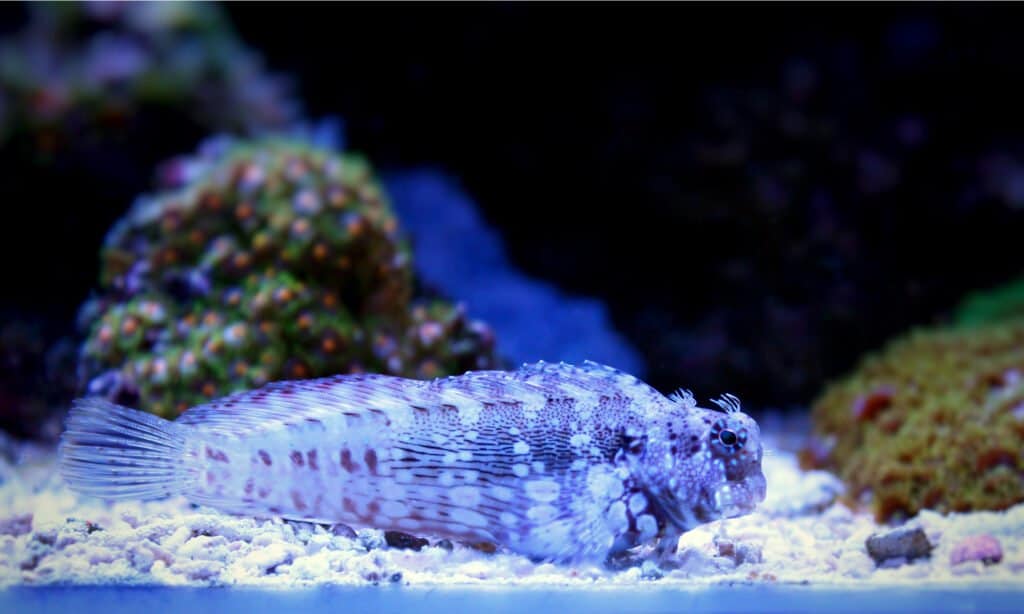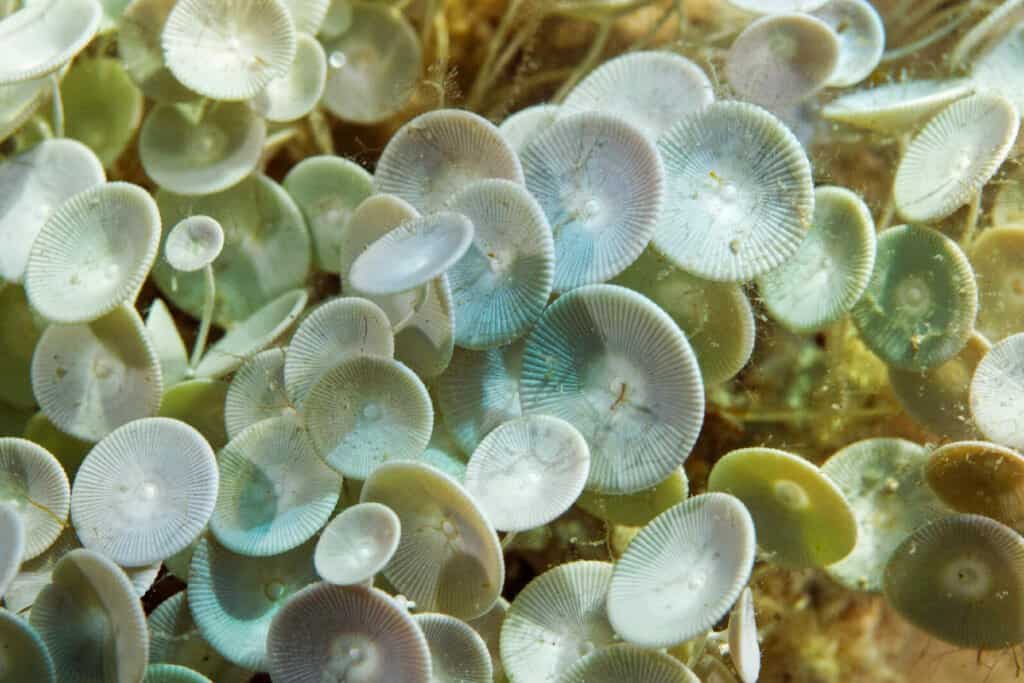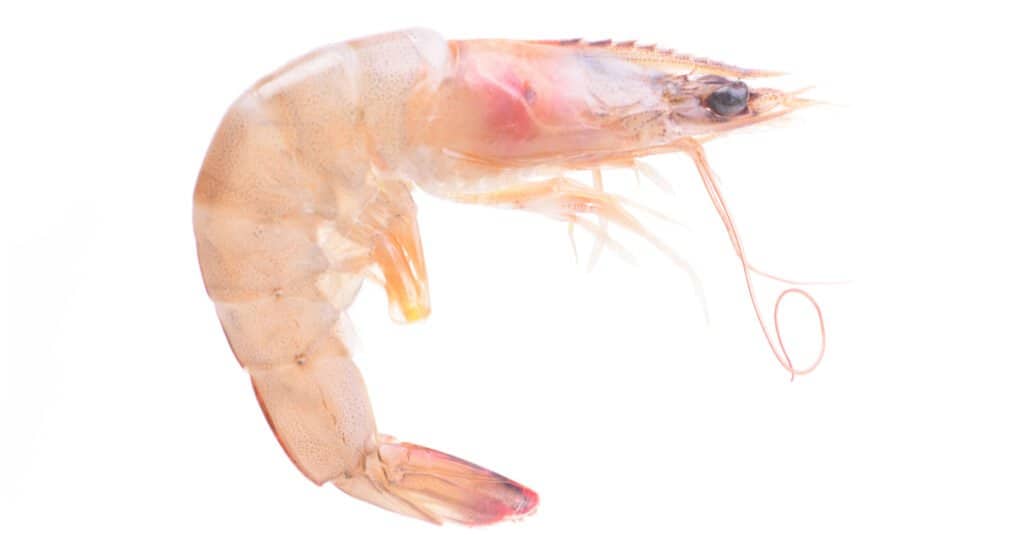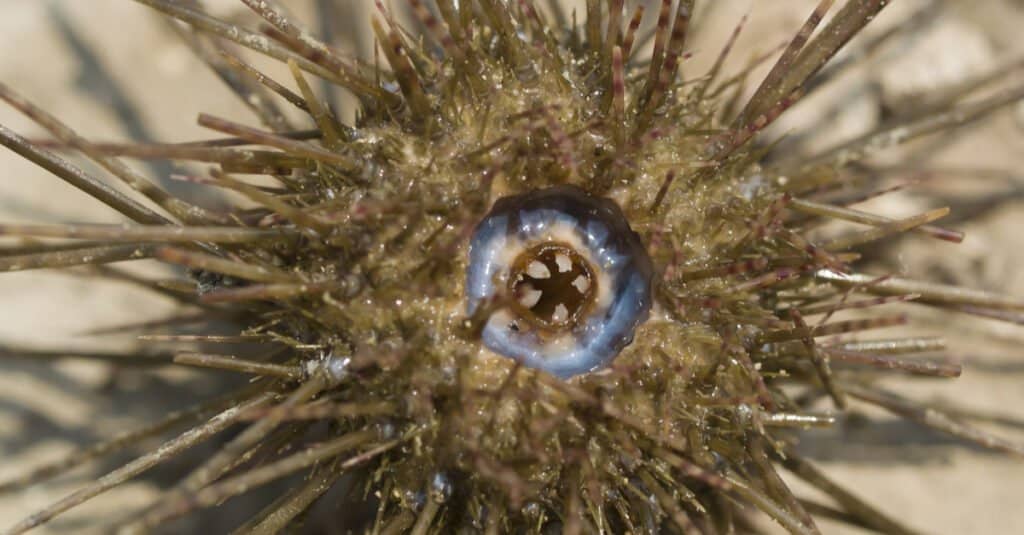Do you know that experts say algae could be the food for the future? According to the BBC, microalgae is rich in amino acids, protein, fatty acids, and vitamins. Even the Journal of Applied Phycology sees algae as nutritional and functional food sources for animals and humans.
Are you still wondering why algae are essential and what is responsible for forming the energy base of the food web for virtually all water-based organisms? We’ll tell you all about it as we go further in this article.
What Are Algae?

Algae blenny in reef aquarium.
©Vojce/Shutterstock.com
Algae are a group of aquatic, autotrophic, nucleus-bearing organisms of the kingdom Protista possessing no true roots, leaves, or stems. They also lack distinctive cells and tissue types such as phloem, stomata, and xylem present in other plants but produce their food and, by extension, provide an energy base for other organisms.
These photosynthetic organisms generate food internally and reproduce through sexual or asexual (vegetative) reproduction methods. Algae thrive in freshwater lakes or saltwater oceans and endure a wide range of temperatures. Some algae survive on land and grow in unexpected places like tree trunks, animal fur, snowbanks, hot springs, and soil.
The Importance of Algae
Without mincing words, algae are an immense contributor to our environment and other creatures because they generate oxygen for all living things through photosynthesis. These aquatic nucleus-bearing organisms produce up to 50% oxygen in the earth’s atmosphere with which humans and other organisms respire. They surprisingly do not compete with plants, but they are helpful as fertilizers to grow crops efficiently. In addition to their many attributes, they boost fish immune systems, improve the fitness of sea invertebrates, give attractive natural looks for aquariums, and help clean the aquarium ecosystem as a form of filtration. Having spoken so highly of these autotrophic organisms, it is only wise we delved a bit to know where they appear on the food chain and what eats algae in general.
What Eats Algae?

Zooplankton, tadpoles, and crustaceans eat algae.
©iStock.com/Goran Safarek
Many aquatic consumers such as zooplankton, tadpoles, algae eater (algivore), small fish, crustaceans, and water-dwelling insects eat algae as their primary food source. Snails, crabs, and sea urchins also eat algae, but they are known to eat red slime algae, green film algae, hair algae, brown film algae, and many other species of algae in the saltwater.
In general, these different species of aquatic consumers feed on algae and, interestingly, along the food chain, fall prey to more enormous sea creatures like fish – which get fed upon by humans. As a fact, algae are the basis of different energy production for plants and animals. Let’s look at what eats algae one by one.
Fish
In freshwater, some fish species like plecostomus, kuhli loach, otocinclus, bristlenose pleco, siamese algae eater, Chinese algae eater, flying fox, and hillstream loach eat algae.
Plecostomus are a group of omnivores that includes all sizes of suckermouth catfish. With plecos’ varying dietary options, they eat up just anything on the menu, from algae, fish food, thawed frozen foods, wood fiber, shrimps to insects.
Octocinclus eat algae and biofilms, which accumulate on plants and rocks.
The Chinese algae eater is a small unique sucker-mouthed fish, and interestingly, its sucker-mouth shape allows it to graze for algae efficiently on rocks and plants.
Hillstream loaches, on the other hand, eat algae. However, they cannot survive solely on these diets for an extended period unless their meal is padded with various other high-quality nutrients.
Shrimp

Being opportunistic omnivores, shrimps eat algae.
©Spayder pauk_79/Shutterstock.com
Shrimps also are excellent algae eaters in freshwater – these sea creatures are opportunistic omnivores that eat anything from algae to plankton. Captivatingly, they aren’t selective with their meals, so they eat all types of algae by default, especially when they accumulate on a hard surface in the tank or ponds. Some popular shrimp species known to eat algae include ghost shrimp, cherry shrimp, Amano shrimp, bamboo shrimp, grass shrimp, snowball shrimp, bee shrimp, and Sulawesi cardinal shrimp.
Snails
Many species of snails in freshwater, including nerite snail, apple snail, ramshorn snail, rabbit snail, pond snail, Malaysian trumpet snail, and sun snail, eat algae. Snails play essential roles in maintaining freshwater aquariums, and they scavenge algae, dead plant materials, dead fish, and other detritus. The incredibly satisfying importance of these snails is helping to recycle waste material and reducing tank maintenance requirements as they inhabit freshwater aquariums.
Crabs
Crabs are omnivores, and intriguingly, they enjoy a meal of protein and algae. The two commonly known algae-eating crabs are the sally lightfoot crab and the common mithrax crab. Several crabs dwell underneath the ocean floor, rocks, and coral reefs. While crabs dwell in these aquatic habitats, they hunt for food ranging from algae, organic matter, carcasses, and waste. With the aid of their claws, these lovely sea creatures grab and put food into their mouths.
Sea Urchins

With the help of their teeth, sea urchins eat algae.
©narupong sooknatee/Shutterstock.com
Sea urchins are good algae eaters who mainly gather in colder, offshore waters. Intriguingly, they travel into shallow waters in search of food. The sea urchins possess a structure called Aristotle’s lantern, consisting of five rigid plates that come together like a beak which enables them to eat. With their beak-like mouth, they scrape rocks clean of algae. Their sharp teeth can also grind up plankton, kelp, periwinkles, and sometimes even barnacles and mussels. Fascinatingly, they regenerate their teeth to replace worn-out ones.
Tadpoles
Tadpoles are primarily herbivores that eat soft plant matter like duckweed, moss, and algae. As a fact, they are too young to have identical diets as frogs. Their diet varies depending on their species, but they hang on to algae meals in the first few days of living.
Other Animals That Eat Algae
- Some turtles (wood turtles, sea turtles, Midland painted turtles, red-eared sliders eat algae)
- Antarctic krill
- Salamanders
- Centipedes
A List of Animals That Eat Algae
Here is a list of animals that eat algae:
- Fish
- Tadpoles
- Snails
- Plankton
- Bluegills
- Shrimp
- Centipedes
- Crabs
- Turtles
Are Green Algae Herbivores?
Algae are often classified as plants and not animals, and sometimes they’re considered protists. Green algae are neither herbivores, carnivores, nor omnivores, and fascinatingly, they make their food through photosynthesis.
How Do Algae Defend Themselves?
It is improbable for any organism to get eaten without wanting to defend itself. Some algae, especially calcium carbonate-rich algae, are complex, mostly rocky, and unattractive, so they tend to use their features to ward off predatory herbivores. These aquatic autotrophs also create defensive chemicals to shield themselves from predators. The likes of green algae contain high-level, toxic, protective chemicals to prevent herbivores from eating them.
The photo featured at the top of this post is © Jesus Cobaleda/Shutterstock.com
Thank you for reading! Have some feedback for us? Contact the AZ Animals editorial team.







